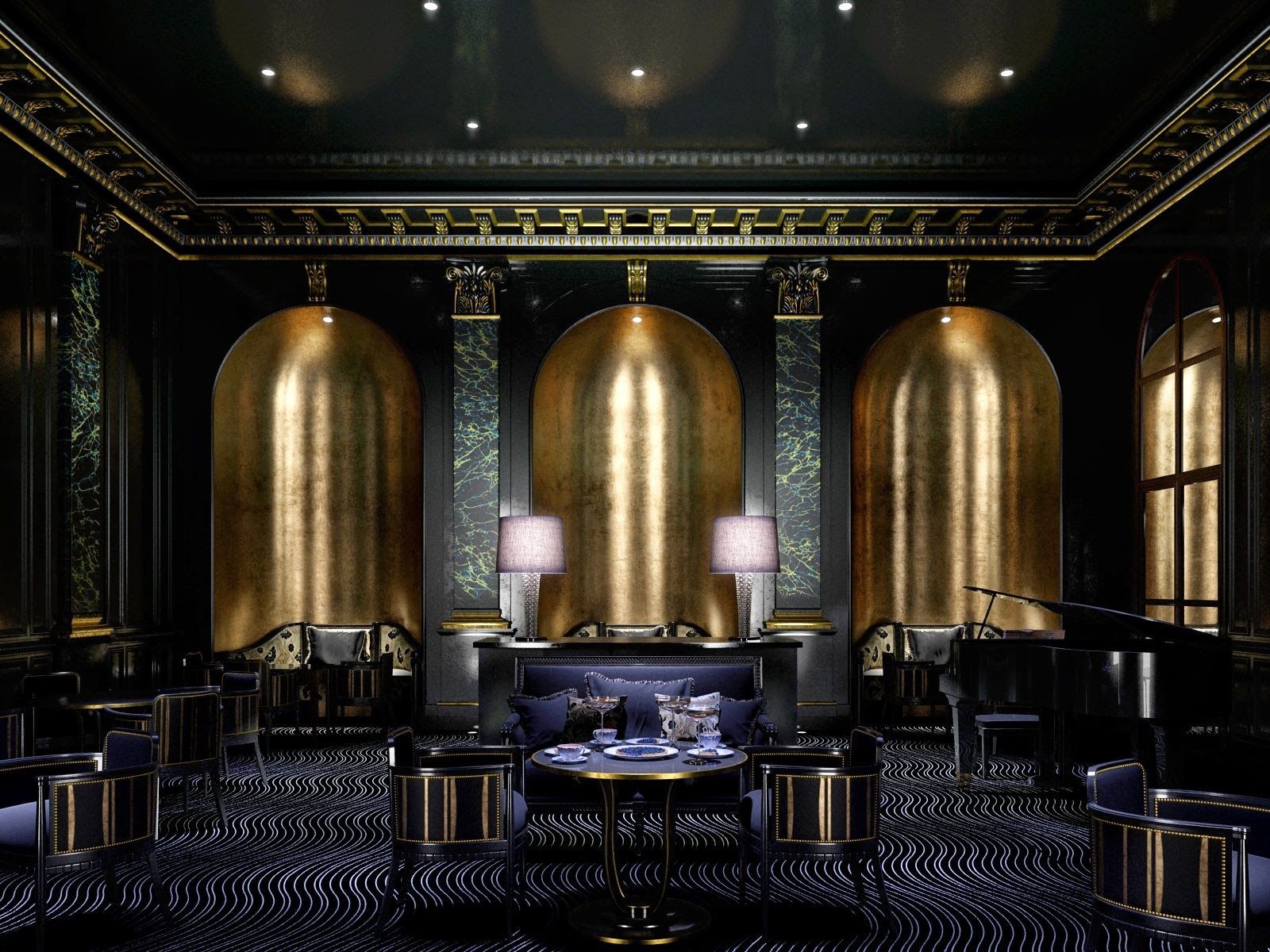Art Deco Renaissance: Bringing the Roaring Twenties Splendor to Modern Interior Design
In the enchanting realm of interior design, the Art Deco movement serves as a tribute to the opulence and charm of the Roaring Twenties.
Originating in the 1920s and reaching its zenith in the 1930s, Art Deco left an enduring imprint on design, infusing it with a luxurious and striking aesthetic that resonates even in contemporary times. This blog delves into the resurgence of Art Deco in modern interior design, exploring its distinctive features, historical context, and lasting influence.
Unveiling the Essence of Art Deco
Embarking on this exploration requires a keen understanding of the contextual backdrop that gave rise to the Art Deco movement. Originating in France in the mid to late 1910s, this design revolution matured notably at the 1925 International Exhibition of Modern Decorative and Industrial Arts in Paris. The exuberance and extravagance of the era permeated various facets of social life, from art and fashion to design, making Art Deco a defining movement of the period. This section unravels the defining characteristics of this iconic style.
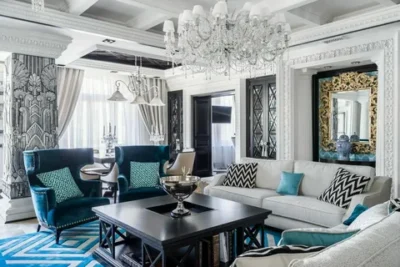
1.1 The Flourishing Characteristics of Art Deco
The Art Deco style draws inspiration from a diverse array of sources, seamlessly weaving together geometric shapes reminiscent of Cubism, the lavish materials associated with the Orient, the sleek aesthetics of modern technology, and the exoticism of ancient civilizations. Influences from Art Nouveau, Bauhaus, Cubism, and Serge Diaghilev’s Ballets Russes form the foundation of this multifaceted design movement. Decorative ideas echo the richness of Native American, Egyptian, and classical influences, as well as the beauty found in nature. This section aims to capture the essence of the Art Deco style and its rich tapestry of inspirations.
1.2 The Global Spread of Art Deco: From Paris to Every Corner of the Earth
Following its grand debut at the Paris World’s Fair in 1925, Art Deco swiftly conquered the design landscape, transcending borders and influencing diverse design disciplines across continents. The style’s emphasis on modernity, coupled with its sumptuous aesthetics, encapsulated the spirit of the Roaring Twenties.
Luxury, sophistication, and progress became synonymous with Art Deco, shaping not only the exteriors and interiors of grand structures but also the design of everyday objects and even the fashion sensibilities of the time.
2. Art Deco: Navigating Through Time
Now that we’ve glimpsed into the contextual origins of Art Deco, let’s embark on a historical journey, tracing its evolution and enduring popularity.
2.1 Origins and Influences: A Tapestry Woven with Geometric Precision
The roots of Art Deco extend to various artistic movements and cultural influences, creating a fascinating tapestry of design elements.
Drawing from Cubism’s geometric rigor, the luxurious allure of the Orient, the functional aesthetics of Bauhaus, and the artistic dynamism of Serge Diaghilev’s Ballets Russes, Art Deco emerged as a unique and influential design language. This section unravels the intricate threads that compose the Art Deco tapestry, offering insights into its diverse origins and influences.
2.2 Origin and Popularity: From Parisian Debut to Global Acclaim
The year 1925 marked a turning point for Art Deco as it took center stage at the International Exhibition of Modern Decorative and Industrial Arts in Paris. This pivotal moment introduced a new artistic direction that resonated globally. The widespread popularity of Art Deco transcended cultural boundaries, influencing design disciplines on a worldwide scale. Synonymous with the spirit of the Roaring Twenties, Art Deco encapsulated an era of innovation, luxury, and progress, shaping the visual landscape of structures, objects, and even personal style.
In the subsequent sections, we delve deeper into the distinctive features of Art Deco in contemporary interior design, exploring how this timeless movement continues to captivate and inspire. Join us on this aesthetic journey through the echoes of the Roaring Twenties brought to life in the modern age.
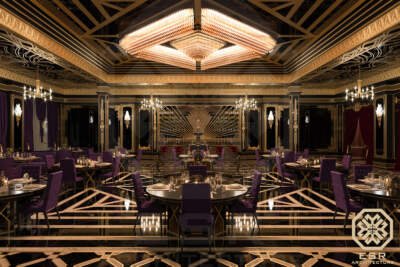
Modern Interior Design: A Resurgence of Art Deco Elegance
In the dynamic world of modern interior design, the resurgence of Art Deco brings forth a renaissance of timeless elegance. Art Deco, characterized by bold geometric shapes, symmetrical compositions, and stylized patterns, encapsulates a design language that has stood the test of time. Let’s explore the main features and the profound effects of Art Deco on contemporary interiors.
2.3 Main Features: A Symphony of Shapes and Luxury Materials
Art Deco is renowned for its bold geometric shapes, symmetrical compositions, and the lavish use of materials such as exotic woods, metals, and lacquered surfaces. The works emanate simplicity and visual pleasure, exuding a sense of dynamism and grandeur. With a focus on decorative details, vibrant colors, and intricate geometric patterns, Art Deco creates a harmonious blend of form and opulence.
3- Art Deco Interior Design: Transforming Spaces with Timeless Appeal
3.1 Effects on Architecture and Interiors: A 1920s Revolution
Art Deco’s profound influence on architectural design during the 1920s and 1930s shaped the aesthetics of buildings with a preference for clean, modern forms.
Characterized by geometric shapes, sophisticated decoration, and intricate details, Art Deco seamlessly integrates into contemporary interior design, transforming living spaces into glamorous and luxurious environments.
3.2 Define Functions: Harmonious Balance and Clean Lines
The interiors of Art Deco strike a harmonious balance between elegance and functionality.
Marked by simple, clear shapes and a “clean” appearance, this style embraces clean lines, smooth surfaces, and a sense of symmetry.
Rooms are designed with a dramatic flair, employing bold geometric patterns and contrasting colors to create visually striking spaces that continue to inspire well into the 21st century.
3.4 Colors and Patterns: Vibrant Hues and Dynamic Designs
Art Deco’s color palette typically contrasts warm browns and pale greens with shiny metals or accents of bold, “pure” colors like rich reds, cobalt blues, or golden yellows. Bold, vibrant colors play a pivotal role, with deep jewel tones adding fullness and intensity. Contrasting color schemes, such as black and gold, or black and white, create a visually striking effect. Geometric patterns, including zigzags and chevrons, adorn walls, floors, and fabrics, injecting dynamic energy into the space.
3.5 Furniture and Decorative Elements: Elegance in Angular Forms
Art Deco furniture is characterized by elegant and angular shapes, featuring curved lines and geometric silhouettes. Craftsmanship shines through marquetry, veneer techniques, and the use of Japanese lacquer for a high gloss finish. Decorative elements like patterned upholstery, luxurious fabrics, and statement lighting fixtures, including chandeliers and sconces, further enhance the overall aesthetic.
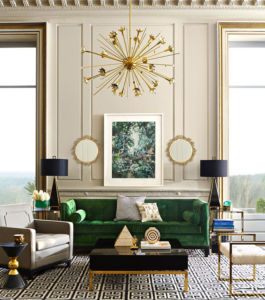
4- Bringing Art Deco Back to Life in Contemporary Interior Design
In the dynamic realm of modern interior design, the revival of Art Deco is evident in various compositions, offering a harmonious blend of nostalgia and modernity.
Let’s explore notable examples that showcase the resurgence of this iconic style.
4.1 The Great Gatsby Mansion: A Modern Interpretation
Drawing inspiration from F. Scott Fitzgerald’s iconic novel, designers have crafted modern interpretations of the magnificent residences depicted in “The Great Gatsby.” These spaces reflect the richness and grandeur of Art Deco, employing fine materials, geometric patterns, and luxurious finishes. With high ceilings, spectacular chandeliers, and sumptuous furnishings, these interiors evoke the splendor and exuberance of the Roaring Twenties.
4.2 Luxury Hotels: A Return to Splendor
Art Deco’s influence has found its way into many luxury hotels worldwide, creating sophisticated and impressive environments. The resurgence of Art Deco in hotel design is observable in grand entrances, elaborate moldings, and intricate ironwork. Rooms subtly embrace an Art Deco vibe, featuring geometric carpets, white lacquer, and shiny chrome and bronze details. Fine materials, geometric patterns, and vibrant colors contribute to an atmosphere of luxury and elegance.
4.3 Living Spaces: Nostalgia Meets Modernity
In home design, Art Deco is experiencing a renaissance as homeowners seek to infuse spaces with a touch of nostalgia and timeless glamour.
Contemporary interpretations combine iconic elements such as geometric wallpaper, mirrored surfaces, and velvet upholstery with modern furniture and technology. The characteristic features of Art Deco express admiration for modernity while embracing elements of structure, flatness, symmetry, and repeatability. The result is a harmonious mix of past and present, creating visually appealing and functional living environments.
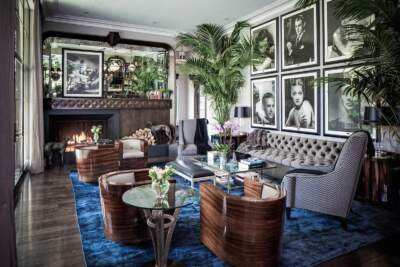
Modern Interior Design: A Harmonious Blend of Past and Present
Keyword: Modern Interior Design
5- Reasons for Awakening: Understanding the Art Deco Revival
Delving into the reasons behind the resurgence of Art Deco in contemporary interior design provides insights into cultural renewal and a desire to embrace prosperity in the postmodern world.
5.1 Nostalgia and Cultural Renewal
The revival of Art Deco in interior design can be attributed, in part,
to a cultural awakening and a nostalgia for the splendor and elegance of the past.
As society evolves, there is a tendency to revisit and celebrate iconic eras that evoke a sense of nostalgia and collective memory.
With its distinctive style and associations with the Roaring Twenties, Art Deco offers a tangible connection to a bygone era,
captivating the imagination and fascination of designers and homeowners.
5.2 Embracing Prosperity in the Postmodern World
In an era dominated by minimalism and understated design, the revival of Art Deco signifies a desire to repurpose opulence and extravagance.
Deviating from the understated aesthetic of contemporary design, Art Deco interiors provide an opportunity to revel in luxurious materials,
vibrant colors, and ornate details.
This style emphasizes wealth and opulence, creating lush and elegant atmospheres that allow individuals to express a sense of richness, individuality, and personal flair. Today, the Art Deco glam style is experiencing its rebirth, providing a refreshing departure from the prevailing design norms.
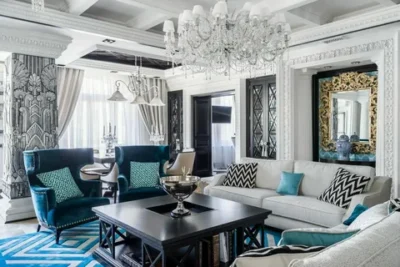
6- Challenges and Adjustments: Navigating the Art Deco Renaissance in Contemporary Interior Design
As the Art Deco movement experiences a renaissance in contemporary interior design,
designers face unique challenges and adjustments in balancing authenticity with modernity.
Let’s explore these challenges and the necessary adjustments to maintain the essence of Art Deco while meeting the demands of today’s lifestyles.
6.1 Balance Between Authenticity and Modernity: Preserving the Essence
Modern Interior Design: Striking the Right Balance
The Art Deco design, representing modernism transformed into fashion, poses a challenge in contemporary settings. The key challenge lies in finding a delicate balance between authenticity and modernity.
While incorporating iconic Art Deco elements, designers must ensure that spaces remain functional and aligned with the demands of modern living.
This often requires adapting Art Deco features to contemporary materials, technologies,
and spatial requirements without compromising the essence and spirit of the style.
6.2 Availability and Comfort: Luxury with Accessibility
The opulence associated with Art Deco design can pose challenges in terms of accessibility and affordability.
Authentic Art Deco features and materials may be rare and expensive,
limiting the embrace of the style for homeowners on a budget.
With the Art Deco style present in various industries, alternatives such as high-quality replicas, vintage finds, or incorporating Art Deco-
inspired elements into existing designs become essential.
By carefully selecting key elements and combining them with more accessible designs,
homeowners can effectively realize the Art Deco aesthetic without exceeding budgetary constraints.
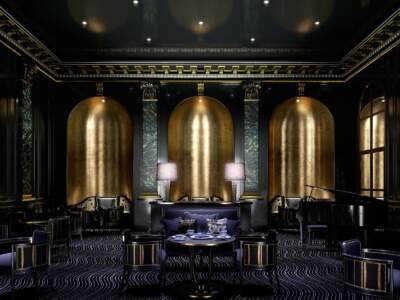
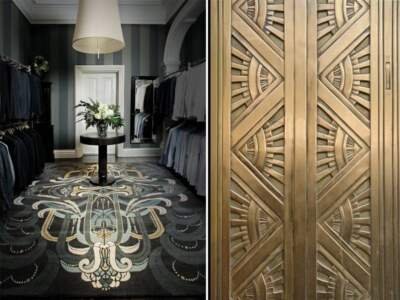
Art Deco Revival and Lasting Legacy
The Art Deco movement, known for its bold, striking, and futuristic style, resurfaces in contemporary interior design,
showcasing its timeless appeal and enduring significance. As the world evolves, designers seek new adaptations and interpretations of Art Deco, often combining it with other design influences. This integration of distinctive Art Deco elements into contemporary spaces allows designers and homeowners to infuse glamour,
nostalgia, and timeless elegance into their surroundings.
Art Deco Emergence and Evolution: A Moment of Aesthetic Experimentation
The Art Deco revival not only pays homage to a bygone era but also illustrates the adaptability and lasting legacy of this influential design movement.
As designers explore new frontiers and combine Art Deco with diverse influences,
the movement’s rich aesthetics continue to leave an indelible mark on the evolving landscape of interior design.
Discover a World of Design Excellence with Saudi Design Group!
Elevate your hotel experience with the innovative designs of Saudi Design Group. Immerse yourself in captivating aesthetics that entice guests to prolong their stay. For more details, connect with us:
Visit our website: saudidesigngroup.com
Subscribe to our YouTube channel: youtube.com/saudidesigngroup
Follow us on Snapchat.
Dear customer, for immediate assistance, reach us on WhatsApp at +966507945715
or call us at +966114222473.
Embark on a journey into the realm of interior design and explore the profound impact of colors.
Read more about….

